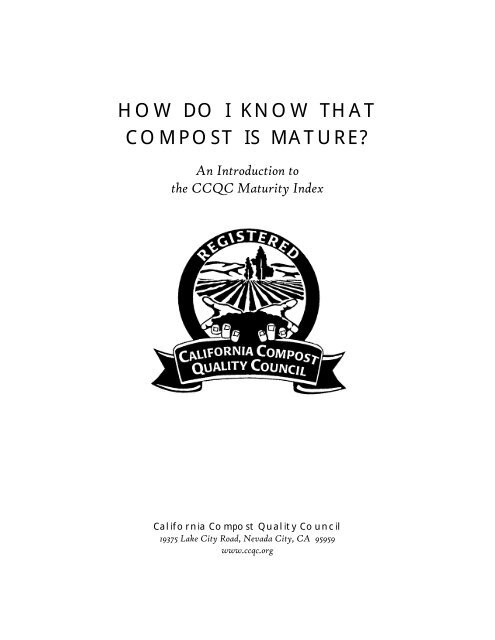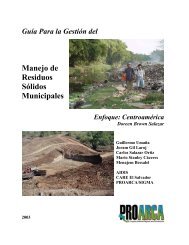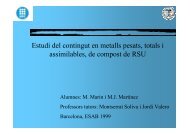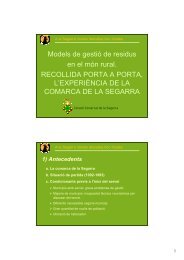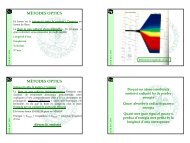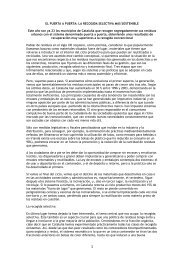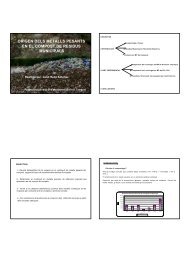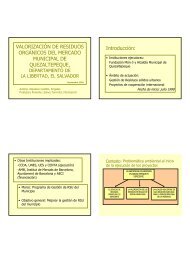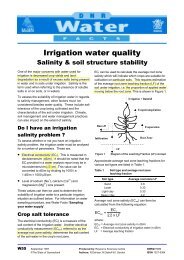An Introduction to the CCQC Maturity Index
An Introduction to the CCQC Maturity Index
An Introduction to the CCQC Maturity Index
Create successful ePaper yourself
Turn your PDF publications into a flip-book with our unique Google optimized e-Paper software.
H O W D O I K N O W T H A T<br />
C O M P O S T I S M A T U R E ?<br />
<strong>An</strong> <strong>Introduction</strong> <strong>to</strong><br />
<strong>the</strong> <strong>CCQC</strong> <strong>Maturity</strong> <strong>Index</strong><br />
California Compost Quality Council<br />
19375 Lake City Road, Nevada City, CA 95959<br />
www.ccqc.org
WHAT IS MATURE COMPOST?<br />
<strong>Maturity</strong> is <strong>the</strong> degree or level of completeness of composting. This means that raw<br />
starting materials (feeds<strong>to</strong>cks) have been sufficiently decomposed under controlled<br />
moisture and aeration conditions that results in a stable organic amendment product.<br />
WHY IS COMPOST MATURITY IMPORTANT?<br />
Most uses of compost require a stable product that will prevent nutrient tie up and<br />
maintain or enhance oxygen availability in soil or growth media. Continued active<br />
decomposition when immature materials are added <strong>to</strong> soil or growth media may have<br />
negative impacts on plant growth due <strong>to</strong> reduced oxygen, water infiltration and/or<br />
available nitrogen.<br />
Most uses of compost require a mature product free of potentially plant <strong>to</strong>xic<br />
components. <strong>An</strong> immature compost may contain or produce high amounts of free<br />
ammonia, certain organic acids, or o<strong>the</strong>r water-soluble compounds which can limit<br />
seed germination and root development.<br />
IF IT LOOKS GOOD, IS IT MATURE?<br />
Use your eyes, but a brown color or <strong>the</strong> look of coffee grounds is not foolproof.<br />
IF IT SMELLS GOOD, IS IT MATURE?<br />
Does <strong>the</strong> compost smell like household cleaner or good rich soil? But be aware that it<br />
is <strong>to</strong>o old it could be more like soil than organic matter.<br />
HOW CAN I TELL IF COMPOST IS MATURE?<br />
<strong>Maturity</strong> is not described by a single property and <strong>the</strong>refore measuring two or more<br />
chemical/biological properties of <strong>the</strong> composted product best assesses maturity.<br />
California Compost Quality Council (<strong>CCQC</strong>) registered compost producers provide<br />
<strong>the</strong>ir most recent labora<strong>to</strong>ry analysis of <strong>the</strong> chemical and physical properties of <strong>the</strong>ir<br />
materials. A numerical <strong>Maturity</strong> <strong>Index</strong> has been developed which uses standard lab<br />
test methods <strong>to</strong> rate compost maturity.<br />
1<br />
California Compost Quality Council www.ccqc.org
<strong>CCQC</strong> MATURITY INDEX<br />
The <strong>CCQC</strong> <strong>Maturity</strong> <strong>Index</strong> uses <strong>the</strong> organic carbon <strong>to</strong> nitrogen ratio and at least one<br />
test from Group A and at least one test from <strong>the</strong> Group B list (see below). Tests from<br />
Group A measure whe<strong>the</strong>r adequate decomposition has occurred by measuring carbon<br />
dioxide release or oxygen use. Tests from Group B measure directly potentially <strong>to</strong>xic<br />
compounds like ammonia or indirectly by measuring seed germination and/or plant<br />
growth.<br />
Carbon <strong>to</strong> Nitrogen (C:N) Ratio<br />
Compost must first have a C:N ratio less than or equal <strong>to</strong> 25 in order <strong>to</strong> be rated as<br />
acceptable prior <strong>to</strong> additional maturity rating from results of tests in Group A and B.<br />
Group A<br />
These tests indirectly measure <strong>the</strong> degree of organic matter decomposition. Lower<br />
values from <strong>the</strong>se tests generally indicate more mature products. Some measure<br />
carbon dioxide release or oxygen consumption by microbes, while <strong>the</strong> heating test<br />
measures heat generated by a sample. Both tests are done for a fixed time period.<br />
Carbon Dioxide Release or Respiration<br />
Oxygen Demand<br />
Dewar Self Heating Test<br />
Group B<br />
These tests measure directly or indirectly chemical characteristics of <strong>the</strong> product,<br />
some of which can be <strong>to</strong>xic <strong>to</strong> plants. Ammonia and organic acids have a maximum<br />
allowable value, while plant tests measure germination rate and root/plant growth in<br />
<strong>the</strong> product and compare it <strong>to</strong> a standard control.<br />
Ammonium:Nitrate Ratio<br />
Ammonia concentration<br />
Volatile Organic Acids concentration<br />
Plant test<br />
2<br />
California Compost Quality Council www.ccqc.org
I N T E R P R E T A T I O N<br />
The three rating categories of <strong>the</strong> index: Very Mature, Mature, and Immature relate<br />
<strong>to</strong> <strong>the</strong> following compost characteristics:<br />
V E R Y M A T U R E M A T U R E I M M A T U R E<br />
Well cured compost Cured compost Uncured compost<br />
No continued decomposition Odor production not likely Odors likely<br />
No odors Limited <strong>to</strong>xicity potential High <strong>to</strong>xicity potential<br />
No potential <strong>to</strong>xicity Minimal impacts on soil N Significant impact on soil N<br />
S E L E C T E D MA T U R I T Y IN D E X RA T I N G VA L U E S FO R C O M P O S T E D PR O D U C T S *<br />
Method Units Rating<br />
Very Mature Mature Immature<br />
CO2 Test C / unit VS / day < 2 2 - 8 > 8<br />
Ammonia : Nitrate Ratio No units < 0.5 0.5 - 3 > 3<br />
Total Ammonia ppm, dry basis < 100 100 – 500 > 500<br />
Seed Germination % of control > 90 80 - 90 < 80<br />
Plant Trials % of control > 90 80 - 90 < 80<br />
*The <strong>CCQC</strong> <strong>Maturity</strong> <strong>Index</strong> requires three different types of tests <strong>to</strong> confirm <strong>the</strong><br />
maturity of a composted product. Many of <strong>the</strong>se tests are standard labora<strong>to</strong>ry tests<br />
compost producers will normally conduct. Additional technical details on <strong>the</strong>se tests<br />
are available from <strong>the</strong> California Compost Quality Council.<br />
3<br />
California Compost Quality Council www.ccqc.org
Select Definitions<br />
MATURITY. The degree or level of completeness of composting. <strong>Maturity</strong> is not<br />
described by a single property and <strong>the</strong>refore, maturity is best assessed by measuring<br />
two or more parameters of compost in part, affected by <strong>the</strong> relative stability of <strong>the</strong><br />
material but also describes <strong>the</strong> impact of o<strong>the</strong>r compost chemical properties on plant<br />
development.<br />
MATURITY INDEX. <strong>An</strong> evaluation procedure <strong>to</strong> describe <strong>the</strong> degree of<br />
decomposition and completeness of a compost process. The maturity <strong>Index</strong> relies on<br />
any two or more test methods performed concurrently on <strong>the</strong> same sample. Test<br />
methods that are applicable are those which have demonstrable relevance <strong>to</strong> stability<br />
and maturity. For a <strong>Maturity</strong> <strong>Index</strong>, tests should include at least one parameter each<br />
from <strong>the</strong> A list and <strong>the</strong> B list (see <strong>Maturity</strong> <strong>Index</strong> Test Methods).<br />
PHYTOTOXIC <strong>to</strong> maturity, phy<strong>to</strong><strong>to</strong>xicity is not a single property of compost.<br />
Fac<strong>to</strong>rs such as salt, volatile organic acids, or ammonia all play a role in determining<br />
phy<strong>to</strong><strong>to</strong>xicity. ITY. A condition or quality of compost that negatively influences<br />
plant growth. Similar<br />
STABILITY. A specific stage or state of organic matter decomposition during<br />
composting, which is related <strong>to</strong> <strong>the</strong> type of organic compounds remaining and <strong>the</strong><br />
resultant biological activity in <strong>the</strong> material. The stability of a given compost is<br />
important in determining <strong>the</strong> potential impact of <strong>the</strong> material on nitrogen availability<br />
in soil or growth media and maintaining consistent volume and porosity in container<br />
growth media.<br />
What is <strong>the</strong> <strong>CCQC</strong>?<br />
The California Compost Quality Council (<strong>CCQC</strong>) represents an unprecedented<br />
alliance of farmers, compost producers, soil scientists, landscape contrac<strong>to</strong>rs,<br />
agricultural advisors, environmentalists, soil testing labora<strong>to</strong>ries, and o<strong>the</strong>rs<br />
interested in increasing <strong>the</strong> production and appropriate use of compost in California.<br />
<strong>CCQC</strong> serves as a forum <strong>to</strong> stimulate dialog between compost producers and users,<br />
develop compost quality criteria, standardize analytical methodology, ensure<br />
compliance through a voluntary moni<strong>to</strong>ring program, and verify claims of products<br />
that meet <strong>the</strong> criteria developed by <strong>the</strong> <strong>CCQC</strong>.<br />
4<br />
California Compost Quality Council www.ccqc.org
Additional Resources on Compost <strong>Maturity</strong><br />
1. "The <strong>CCQC</strong> <strong>Maturity</strong> <strong>Index</strong>" (Final Report). Available from <strong>CCQC</strong><br />
(www.ccqc.org)<br />
2. "The <strong>CCQC</strong> Guide <strong>to</strong> Compost <strong>Maturity</strong>". Available from <strong>CCQC</strong><br />
(www.ccqc.org)<br />
3. "Compost: Matching Performance Needs with Product Characteristics”, Available<br />
from <strong>the</strong> CIWMB, 916-341-6620<br />
4. "How Agricultural End Users Can Access Compost Quality, Jean Vandergheynst,<br />
UC Davis, Available from <strong>the</strong> CIWMB (916) 341-6620<br />
5. Compost – A Guide for Evaluating and Using Compost Materials as Soil<br />
Amendment. William Darling<strong>to</strong>n, Soil and Plant Labora<strong>to</strong>ries, Inc. Available<br />
from <strong>the</strong> CIWMB at 916-341-6620.<br />
LIMITATIONS<br />
Compost producers and users should realize that <strong>the</strong> presently accepted methods <strong>to</strong><br />
evaluate stability and maturity may not completely or precisely address <strong>the</strong> most<br />
important concern, ‘Is it appropriate for <strong>the</strong> particular end-use?’. All of <strong>the</strong> test<br />
procedures described in this document and <strong>the</strong> complete <strong>CCQC</strong> <strong>Maturity</strong> <strong>Index</strong><br />
Report provide indirect interpretations for <strong>the</strong> potential impact on plant growth. In<br />
most cases <strong>the</strong>se tests and determinations are performed on samples comprised of 100<br />
percent compost. However, compost is used as an additive that may range from 30<br />
percent <strong>to</strong> less than 1 percent of <strong>the</strong> <strong>to</strong>tal media or soil volume. In <strong>the</strong> absence of even<br />
more specific tests that evaluate <strong>the</strong> material based on a particular use, it is very<br />
important for <strong>the</strong> producer of compost <strong>to</strong> become more aware of <strong>the</strong> requirements for<br />
different end-use markets.<br />
5<br />
California Compost Quality Council www.ccqc.org


